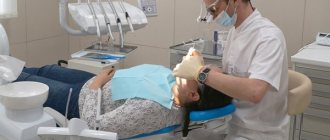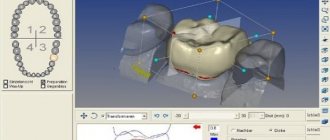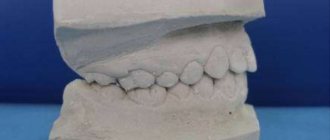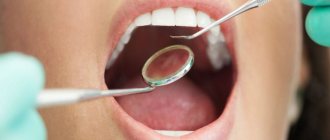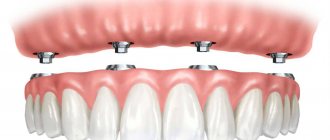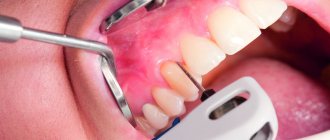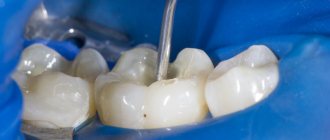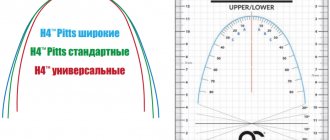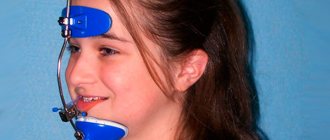Dental arch is a term denoting a conventional line drawn along the incisal and vestibular edge of the tooth crowns. The upper dental arch is formed by the upper teeth from 1 to 8, the lower dental arch, accordingly, is formed by the lower teeth from 1 to 8.
The shape of the dental arch can be V or U-shaped. The first type is more often observed in individuals who have narrow intercanine distances. The second type is characteristic of individuals with a wide distance between the fangs.
If there is a full dental arch, a person can chew normally, his pronunciation is not impaired, and the appearance of his teeth is aesthetic. If for some reason the dentition changes abnormally, then this is a direct indication for visiting a qualified dentist. Various arch defects can be eliminated using invasive and non-invasive techniques (for example, installation of orthodontic structures).
Facial bow in orthopedics
Dentures are made individually for each patient, taking into account the structure of his dental system. To do this, a few years ago, the prosthetist took impressions of the teeth, described the bite and sent the data obtained to the dental laboratory, where the prosthesis was made in strict accordance with them. Theoretically, the orthopedic product should have “fitted” perfectly, but in practice the doctor sent it to the laboratory several times for revision. The grueling “adjustment” was associated mainly with the specific trajectory of movement of the lower jaw, a clear idea of which was not given by either dental impressions or a description of the bite. It was possible to fill the gap in data thanks to the facial bow, which models the position of the jaw in three-dimensional space, and allows you to create not only a comfortable, but also a harmonious denture that matches a person’s facial features and makes his smile natural.
Design and types of orthopedic facial arches
A facebow is a U-shaped metal plate equipped with a bite fork and secured to the head with stops. There are two types of orthopedic face bows:
- Medium anatomical (synonyms: portable, standard) facebow. The device is fixed using the nose and ear stops. Used to create complete removable dentures.
- Kinematic (synonym: axial) arc. The device is fixed at the point of the chin and the midline of the forehead; establishes not only the relationship of the jaws, but also their axis during movement. Used in the manufacture of partial dentures from acrylic and elastic materials such as nylon.
Purpose and use of the device
Purpose. The facial bow is a measuring device that establishes the relationship of the upper and lower jaws, as well as their position relative to the bones of the skull. The face bow, including in the St. Petersburg GrandMed clinic, is used both to determine the axis of rotation of the mandibular condyle (the bony protrusion to which the muscles are attached), and to transfer the position of the upper jaw and the axis of rotation of the lower jaw to the articulator.
Application. The face bow is fixed on the head using stops. A bite tray filled with an impression mass is attached to the device, which is introduced into the patient’s oral cavity. The structure is fastened and adjusted with screws. The patient follows the standard instructions of the dentist, the specialist takes the necessary measurements and registers the bite (receives impressions of the upper and lower jaws). Next, the face bow is removed, the data obtained is sent to the laboratory, where it is transferred to an articulator (a device that imitates the movements of the lower jaw). Thanks to the use of a face bow, orthopedic products are obtained that take into account the peculiarities of the orientation and trajectory of movement of the human jaws.
Benefits for the patient
Just a few minutes of spatial modeling using a facebow greatly facilitates the work of the orthopedic doctor at the GrandMed clinic and the technician who will manufacture the prosthesis. At the same time, the accuracy of the specialists’ work increases, which means:
- fewer product fittings will be required;
- the period of adaptation will be shortened, and less time will be required to restore chewing and articular functions due to taking into account the anatomical features of the jaws;
- the smile will look aesthetically pleasing, because the teeth in the frontal group will take a natural position relative to the lips, nose and eyes, and will not be adjusted to an abstract “ideal”.
- the prosthesis, supporting teeth and implants with which it is connected are ensured a long service life due to the correct distribution of the load.
Attention! Studies using a facebow do not replace, but complement standard methods of diagnosis and orthopedic treatment, such as taking impressions and determining central occlusion.
Medical Internet conferences
L.V. Muzurov – Saratov State Medical University named after. IN AND. Razumovsky Ministry of Health of Russia, Professor of the Department of Human Anatomy, Doctor of Medical Sciences, Professor; M.V. Mikheev - Saratov State Medical University named after. IN AND. Razumovsky Ministry of Health of Russia, Department of Human Anatomy, postgraduate student; V.V. Konnov – State Budgetary Educational Institution of Higher Professional Education Saratov State Medical University named after. IN AND. Razumovsky Ministry of Health of Russia, Head of the Department of Orthopedic Dentistry, Doctor of Medical Sciences, Associate Professor; S.N. Sheludko - Saratov State Medical University named after. IN AND. Razumovsky, Ministry of Health of Russia, Department of Human Anatomy, postgraduate student.
Summary
Purpose: to study the variability of the parameters of the dental arch of the lower jaw in women with different face shapes. Material and methods. The study of the morphometric parameters of diagnostic jaw models was carried out in 92 women aged 21 to 51 years. For all those examined, the shape of the face (morphological index) was determined according to Garson (1910): very wide face (hypereuryprosopic); wide face (euryprosopic); middle face (mesoprosopic); narrow face (leptoprosopic); very narrow face (hyperleptoprosopic). Results. The width of the dental arch of the lower jaw at the level of premolars and molars has the largest average values in mesoprosopic women, and the smallest in hyperleptoprosopic women. The largest average values of the length of the dental arch are characteristic of leptoprosops, and the smallest - hypereuryprosops. The length of the anterior segment of the dental arch has a maximum average value in hypereuryprosops and euryprosops, and a minimum in hyperleptoprosops. In all groups, regardless of the shape of the face, flattening of the anterior segment of the dental arch of the lower jaw is determined. The greatest degree of flattening is characteristic of hyperleptoprosops. The largest average width of the basal arch is characteristic of mesoprosops, and the smallest - hypereuryprosops. In the group of hypereuryprosopians, a narrowing of the basal arch of the lower jaw of the first degree is determined. The length of the basal arch has the largest average value in hypereuryprosops, and the smallest in mesoprosops. In all groups, regardless of the shape of the face, a shortening of the length of the basal arch of the lower jaw is determined, most pronounced in meso- and leptoprosopians. Conclusion. The data obtained must be taken into account when conducting orthodontic and orthopedic treatment, when giving lectures and conducting practical classes at the departments of human anatomy and departments of dental specialization.
Introduction. In practical dentistry, the private constitution represents the characteristics of the skull that must be taken into account when carrying out treatment. Many studies have proven the influence of structural features of the skull and face on the dental system. The features of the jaws that determine the individuality of the face are also noted.
Purpose of the study: to study the variability of the parameters of the dental arch of the lower jaw in women with different face shapes.
Objects and methods of research . The study of the morphometric parameters of diagnostic jaw models was carried out in 92 women aged 21 to 51 years, who are indigenous residents of the Saratov region. To determine cephalometric parameters and measurements of diagnostic jaw models, a standard set of anthropometric instruments that passed metric testing were used: small thick and sliding compasses (with a millimeter scale); technical electronic caliper with a division value of 0.01 mm. For all those examined, the shape of the face (morphological index) was determined according to Garson (1910) - the ratio of the morphological height of the face to the width of the face in the area of the zygomatic arches × 100. According to this index, the following types of faces were distinguished: very wide face (hypereuryprosopic) - index 78.9 and less; wide face (euryprosopic) – index 79.9-83.9; average face (mesoprosopic) – index 84.0-87.9; narrow face (leptoprosopic) – index 88.0-92.9; very narrow face (hyperleptoprosopic) – index 93.0 or more.
Results. The width of the dental arch of the lower jaw at the premolar level in women with different face shapes ranges from 32.0 mm to 43.0 mm. The highest value of the parameter is determined in women with a mesoprosopic face type (37.0 mm). In other groups the parameter is smaller: in hypereuryprosops by 0.8 mm (P>0.05); in euryprosopes by 0.9 mm (P>0.05); in Leptoprosopus by 0.6 mm (P>0.05); in hyperleptoprosops by 2.2 mm (P<0.05). The lowest value of the parameter is determined in women with hyperleptorosopic facial type (34.8 mm). In all selected groups, the parameter varies slightly (CV = 4.9-9.3%).
The width of the dental arch of the lower jaw at the level of the molars ranges from 42.0 mm to 58.0 mm. The highest average value of the parameter is determined in women with a mesoprosopic face type (52.8 mm). In other groups, this parameter is less: in hypereuryprosops by 1.4 mm (P>0.05); in euryprosopes by 2.2 mm (P<0.05); in Leptoprosopus by 3.1 mm (P<0.05); in hyperleptoprosops by 4.2 mm (P<0.05). The lowest value of the parameter is determined in women with a hyperleptoprosopic type of face (48.6 mm). In all groups the parameter varies slightly (CV=5.9-7.4%).
The length of the dental arch of the lower jaw in women with different types of faces ranges from 83.0 mm to 115.0 mm. The highest value of the parameter is determined in leptoprosopus (96.6 mm). In other groups the parameter is smaller: in hypereuryprosops by 4.6 mm (P<0.05); in euryprosopes by 1.0 mm (P>0.05); in mesoprosopians by 3.3 mm (P<0.05); in hyperleptoprosops by 2.1 mm (P<0.05). The lowest value of the parameter was found in women with hypereuryprosopic facial type (92.0 mm). In mesoprosopians the parameter varies slightly (CV=8.1%), in other groups it varies moderately (CV=11.1-12.1%). Analysis of the correspondence of the length of the dental arch of the lower jaw to the sum of the mesio-distal dimensions of 12 teeth showed that for all types of faces in women, the length of the dental arch is greater than the sum of the mesio-distal dimensions of 12 teeth. The index of the dental arch of the lower jaw in women with different types of faces ranges from 37.1 to 65.9. The highest average value is determined in hypereuryprosops (56.2), the lowest - in leptoprosops and hyperleptoprosops (51.9).
The length of the anterior segment of the dental arch of the lower jaw in women with different face shapes ranges from 6.8 mm to 13.4 mm. The highest values of the parameter are determined in the group of hypereuryprosops and euryprosops, having almost equal average values in these groups (10.6 mm and 10.7 mm, respectively). In other groups the parameter is smaller: in mesoprosops and hyperleptoprosops by 2.0 mm (P<0.05); in Leptoprosopus by 0.9 mm (P>0.05). In the group of mesoprosops and hyperleptoprosops, the parameter is the smallest and has equal average values (8.8 mm and 8.7 mm, respectively). In all groups the parameter varies averagely (CV=14.3-18.4%). In all groups, flattening of the anterior segment of the dental arch of the lower jaw is determined.
The length of the lateral segment of the dental arch of the lower jaw in women with different types of faces ranges from 21.4 mm to 43.6 mm. The study showed that in all groups there were no bilateral differences and no statistically significant differences for different facial types.
The width of the basal arch of the lower jaw in women with different types of faces ranges from 32.5 mm to 40.6 mm. The highest value of the parameter is determined in mesoprosopes (36.1 mm). In other groups the parameter is smaller: in hypereuryprosops by 2.1 mm (P<0.05); in euryprosopes by 1.6 mm (P<0.05); in Leptoprosopus by 0.5 mm (P>0.05); in hyperleptoprosops by 1.0 mm (P>0.05). The lowest value of the parameter is determined in hypereuryprosops (34.0 mm). In all groups, insignificant variability of the parameter was revealed (CV = 7.7-9.9%). In hypereuryprosopus and leptoprosopus, a narrowing of the basal arch of the lower jaw of the first degree was revealed.
The length of the basal arch of the mandible in women with different face shapes ranges from 27.3 mm to 38.8 mm. The highest and almost equal average values are determined for hypereuryprosops (31.9 mm) and hyperleptoprosops (32.0 mm). In other groups, the parameter is slightly and statistically insignificant (P>0.05) less: in leptoprosopes by 0.1 mm; in euryprosopes by 0.9 mm; in mesoprosopes by 1.0 mm. The lowest value of the parameter is determined in mesoprosopes (31.0 mm). In all groups, insignificant variability of the parameter was revealed (CV = 5.9-9.9%). In women with different types of faces, shortening of the basal arch of the mandible was revealed in all groups.
Discussion. There is no data in the literature on the variability of the morphometric parameters of the dental arch of the lower jaw in women with different face shapes. The available data characterize these parameters only in connection with the identified occlusions.
According to the literature, the width of the dental arch of the lower jaw at the premolar level averages 22.2-25.5 mm [1]; varies from 28.0 mm to 43.0 mm and averages 37.0 mm [2]. According to our data, in women with different face shapes, the parameter ranges from 32.0 mm to 43.0 mm and averages 36.1 mm. The data we obtained is greater than the data given in the literature.
According to the literature, the width of the dental arch of the lower jaw at the level of the molars varies from 42.81 mm to 53.41 mm [3, 4]; from 56.0 mm to 67.5 mm (X = 50.7 mm) [5]; from 47.62 mm to 56.26 mm (X = 51.6 mm) [6]; 29.9-34.5 mm [1]. In adults, according to the literature, the parameter is on average 37.9 [7]; 52.4-56.3 mm [8]; is in the range from 53.7 mm to 62.2 mm [9]. According to our data, in women with different face shapes, the parameter ranges from 42.0 mm to 58.0 mm and averages 50.6 mm. Our data coincide with the data of S.S. Rtishcheva (2012) [8].
According to the literature, the length of the dental arch of the lower jaw in adults varies from 106.9 mm to 113.5 mm [10], is in the range of 98.6-106.9 mm [8], and averages 95.5-100 .3 mm [3], varies from 82.0 mm to 110.0 mm and on average is 94.3 mm [7]. According to our data, in women with different face shapes, the parameter ranges from 83.0 mm to 115.0 mm and averages 94.4 mm. Our data coincide with the literature data.
According to the literature, the length of the anterior segment of the dental arch of the lower jaw in adults ranges from 8.9 mm to 10.3 mm [3]; from 5.4 mm to 16.3 mm and an average of 10.4 mm [7]. According to our data, in women with different face shapes, the parameter ranges from 6.8 mm to 13.4 mm and averages 9.7 mm.
According to the literature, the width of the basal arch on the lower jaw in adults averages 35.8-39.3 mm [3]; is in the range of 32.4-43.4 mm and on average is 36.6 mm [7]. According to our data, in women with different face shapes, the parameter ranges from 32.5 mm to 40.6 mm and averages 35.1 mm.
According to the literature, the length of the basal arch of the mandible in adults averages 30.6-33.8 mm [3]; is in the range of 25.5-39.8 mm and on average is 32.4 mm [7]. According to our data, in women with different face shapes, the parameter ranges from 27.3 mm to 38.8 mm and averages 31.6 mm.
Conclusion. The width of the dental arch of the lower jaw, measured at the level of premolars and molars, has the largest average values in mesoprosopic women, and the smallest in hyperleptoprosopic women. The largest average values of the length of the dental arch of the lower jaw are characteristic of leptoprosops, and the smallest - hypereuryprosops.
The length of the anterior segment of the dental arch of the lower jaw has a maximum average value in hypereuryprosops and euryprosops, and a minimum in hyperleptoprosops. In all selected groups, regardless of the shape of the face, flattening of the anterior segment of the dental arch of the lower jaw is determined. The greatest degree of flattening is characteristic of hyperleptoprosops.
The largest average width of the basal arch of the lower jaw is characteristic of mesoprosops, and the smallest - hypereuryprosops. In the group of hypereuryprosopians, a narrowing of the basal arch of the lower jaw of the first degree is determined.
The length of the basal arch of the lower jaw has the largest average value in hypereuryprosops, and the smallest in mesoprosops. In all groups, regardless of the shape of the face, a shortening of the length of the basal arch of the lower jaw is determined, most pronounced in meso- and leptoprosopians.
Conflict of interest. The work was carried out as part of the research work of the Department of Human Anatomy and the Department of Orthopedic Dentistry, Saratov State Medical University named after.
IN AND. Razumovsky, Ministry of Health of Russia.
Facebow in orthodontics
If prosthetists use a facebow to identify the characteristic features of the dental system, that is, for diagnosis, then for an orthodontist, a facebow is a device used together with braces to correct defects caused by a lack of space in the dentition and improper development of the jaw. The face bow is an inexpensive but quite effective device that gives stable results in 4–6 months, which, from the point of view of orthodontics, is a rather short period of time. The bulky appearance of the design, which confuses many patients, is compensated by the ease of its installation and removal and the inconsistency of wear (day or night - at the patient’s choice, but not less than 12 hours a day).
Design and types of orthodontic facial arches
An orthodontic facebow is a metal (made from a hypoallergenic medical alloy) elastic structure. The system consists of two laser-welded fragments that are attached to the head or neck, and are also attached to the teeth with special fasteners. Outside the mouth, the face bow is fixed:
- In the back of the neck . The device is used to correct defects of the lower jaw.
- On the back of the head. The device creates high traction and is used to solve problems with the upper jaw.
- On the neck and back of the head. The combined device provides two types of traction and is suitable for correcting complex anomalies of the dental system.
Purpose and use of the device
Purpose. Since the orthodontic facebow performs therapeutic (corrective) functions, there must be indications for its use. Most often this is abnormal jaw growth, crowding or random movement of molars. For orthodontic treatment, universal face arches are used, which the specialist simply adjusts to each patient, focusing on the data of a panoramic image and an x-ray of his jaws.
Application. Before installing a facebow, you should consult with a periodontist, perform professional oral hygiene and treat your teeth for caries. You may need to consult a surgeon, especially if there are problems with the mandibular joint. It is recommended to wear the facebow 10–14 hours a day, usually at night, and sleep exclusively on your back. Night use is desirable not only for ethical reasons - it allows you to avoid injury and irritation of the device on the gum mucosa. The safest designs are those with a neck fastening. After removal, the face bow must be washed with water (soap or solutions with antiseptic properties can be used for disinfection); the structure is stored in a special case in a dry state.
Benefits of using a facebow for the patient:
- restores the correct position of chewing teeth (molars) after forced tooth extraction due to crowding;
- frees up space for the frontal teeth by moving the molars;
- inhibits jaw growth.
Attention! A facebow does not replace braces, but is prescribed along with them. A facebow cannot be used if the patient is allergic to metal or has inflammation of the temporomandibular joint and periodontal tissue.
Advantages of YuliSTOM dental clinics
- Specialists have experience in carrying out this procedure and special knowledge;
- During events, only disinfected instruments are used;
- Availability of expensive equipment of the latest models;
- Modern technologies are used in treatment;
- High service culture. Patients do not need to stand in line. You can make an appointment for a specific time by phone or using the form on the website;
- Only high-quality materials are used for treatment and prosthetics;
- Guarantee of the quality of the work performed;
- There are discounts and bonuses for regular customers;
- Yulistom holds seasonal promotions for certain types of services;
Moscow metro station Zvezdnaya, Danube Avenue, 23
How much does treatment using a facebow cost in St. Petersburg? Price at GrandMed dentistry
In our clinic, when performing prosthetics, a face bow is necessarily used, which allows us to obtain data on the peculiarities of the location of the patient’s jaws, so there is no additional cost for three-dimensional modeling. The cost of treatment using an orthodontic facebow depends on the complexity of the defect, the condition of the dental system, the type of structure fixation and the age of the patient. Since the design can be prescribed to the patient only after the removal of foci of caries and professional hygienic cleaning, and in addition, an X-ray examination (panoramic X-ray, X-ray of the jaws), the cost of therapeutic and diagnostic procedures must be taken into account when determining the full cost of the face bow.
| Service | Price from |
| 3D modeling using a facebow | included in the cost of prosthetics |
| Orthodontic facebow | included in the cost of orthodontic treatment |
Indications
Indications for basal implantation are:
- absence of more than three teeth;
- loss of all teeth;
- impossibility of classical implantation;
- diabetes;
- periodontal disease;
- periodontitis;
Before basal implantation, it is necessary to cure caries and other dental diseases. Then the doctor will use a computer to simulate the structure. The implants are installed and then the prosthesis.

